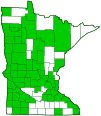showy milkweed
(Asclepias speciosa)
Conservation • Wetland • Description • Habitat • Ecology • Use • Distribution • Taxonomy
Description |
||
Showy milkweed is an erect, perennial forb that rises from a deep rhizome. It often forms colonies. The leaves and stems are velvety and contain a milky juice. The stems are erect, usually unbranched, and hairy. The leaves are opposite, untoothed, 2½″ to 8″ long, up to 4″ wide, and egg-shaped. They have pointed tips and rounded bases. They are attached to the stem on short leaf stalks. There are conspicuous veins running from the midrib to the edge. The lower surface is hairy. The inflorescence is one or more loose, umbrella-shaped clusters (umbels) rising from the upper leaf axils and at the end of the stem. The clusters are 2″ to 3″ in diameter and are on a 1″ to 3″ long, woolly, stalk. They typically have 10 to 20 flowers. The structure of the typical milkweed flower is unique and instantly recognizable. There are 5 petals bent backward at the base and hanging downward. Subtending the petals are 5 much shorter, light green, lance-shaped sepals. There are 5 stamens. Formed from the filament of each stamen is a petal-like appendage. The appendage consists of a tubular hood surrounding an awl-shaped horn in the center of the hood. The stamens and the stigma are fused together into a crown-like structure (gynostegium). Each stigma has a long slit designed to catch the legs of a pollinating insect. A small, dark, sticky gland above this slit is attached to pollen sacs from adjacent anthers. These glands are designed to break off as an insect pulls its leg free of the slit, and remain attached to the insects leg. The flowers are pollinated by larger insects strong enough to lift off with the pollen sacs attached. Smaller insects are caught in a death trap or leave behind their detached legs. The flowers of this plant are shaped like the typical milkweed flower but are larger than those of any other milkweed. They are ¾″ to 1½″ tall, ½″ to 1⅛″ wide, and are attached on ⅜″ to 1⅛″ long stalks. The petals are pink or reddish purple. They bend backward at the base, hang downward, then curl upward near the tip. They are attached directly below the hoods without a separating column. The hoods are ⅓″ to ⅔″ long and abruptly narrowed below the middle to an linear to oblong tip, and are taller than the gynostegium. Collectively, the hoods are in the shape of a 5-pointed star. They are white or the same color as the petals but much paler. The horns are shorter than the hoods. They project from the hoods and are curved inwards. There is little or no fragrance. The fruit is a fat, spindle-shaped pod. It is 2¾″to 4¾″long and ¾″ to 1½″ thick. It is densely warty and densely covered with white, wooly hairs. It is held erect or ascending on an erect stalk. It opens on one side exposing the seeds to spreading by the wind. The seeds have a tuft of hairs at the tip that are whitish and about 1⅛″ long. |
||
Height |
||
12″ to 36″ |
||
Flower Color |
||
Pink or reddish purple |
||
Similar Species |
||
|
||
Habitat |
||
Moist. Prairies. Full sun. |
||
Ecology |
||
Flowering |
||
June to August |
||
Faunal Associations |
||
Milkweeds are the only plants that Monarchs lay their eggs on. The eggs are laid on the underside of healthy young leaves. |
||
Toxicity |
||
This and other milkweeds contain cardiac glycosides and may be poisonous to both humans and livestock. |
||
Pests and Diseases |
||
|
||
Use |
||
|
||
Distribution |
||||
|
Sources |
|||
| 5/31/2023 | ||||
Nativity |
||||
Native |
||||
Occurrence |
||||
Locally common but not abundamt |
||||
Taxonomy |
|||
| Kingdom | Plantae (Plants) | ||
| Division | Tracheophyta (Vascular Plants) | ||
| Subdivision | Spermatophytina (Seed Plants) | ||
| Class | Magnoliopsida (Dicots) | ||
Order |
Gentianales (Gentians, Dogbanes, Madders, and Allies) | ||
Family |
Apocynaceae (dogbane) | ||
| Subfamily | Asclepiadoideae (milkweeds) | ||
| Tribe | Asclepiadeae | ||
| Subtribe | Asclepiadinae | ||
Genus |
Asclepias (milkweeds) | ||
Subordinate Taxa |
|||
|
|||
Synonyms |
|||
Asclepias douglasii Asclepias giffordii |
|||
Common Names |
|||
greek milkweed showy milkweed |
|||
Glossary
Axil
The upper angle where the leaf stalk meets the stem.
Gynostegium
A crown-like structure of plants of the genus Asclepias formed by the fusion of the anthers with the stigmas.
Linear
Long, straight, and narrow, with more or less parallel sides, like a blade of grass.
Rhizome
A horizontal, usually underground stem. It serves as a reproductive structure, producing roots below and shoots above at the nodes.
Umbel
A flat-topped or convex, umbrella-shaped cluster of flowers or buds arising from more or less a single point.
Visitor Photos |
|||||
Share your photo of this plant. |
|||||
| This button not working for you? Simply email us at info@MinnesotaSeasons.com. Attach one or more photos and, if you like, a caption. |
|||||
Dan W. Andree |
|||||
Blooming Milkweed....Sandpiper Prairie SNA... |
|||||
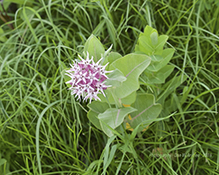 |
|||||
MinnesotaSeasons.com Photos |
|||||
Plant |
|||||
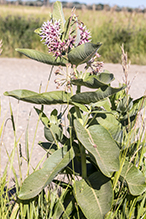 |
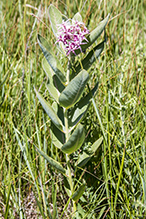 |
||||
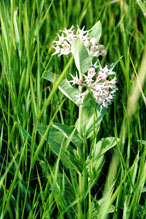 |
|||||
Inflorescence |
|||||
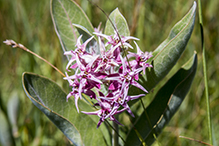 |
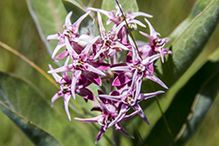 |
||||
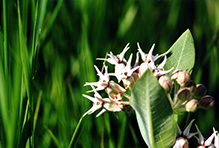 |
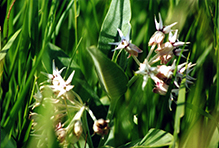 |
||||
Flowers |
|||||
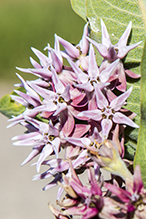 |
|||||

Slideshows |
||

Visitor Videos |
|||
Share your video of this plant. |
|||
| This button not working for you? Simply email us at info@MinnesotaSeasons.com. Attach a video, a YouTube link, or a cloud storage link. |
|||
Other Videos |
|||
| Showy Milkweed.mp4 gnwyfdn |
|||
About
Uploaded on Sep 1, 2011 This video is part of the Upstream hiking series that can be read in the Greenway Foundation's monthly newsletter. Read the original article here: http://www.gnwy.org/web/index.php?cID=116 |
|||
| Bee pollinators on Showy Milkweed (Asclepias specosia) GrowMilkweedPlants.com |
|||
About
Published on Jun 8, 2014 This video is about Bee pollinators on Showy Milkweed (Asclepias specosia). Filmed at Mayberry Park Reno Nevada June 8th 2014. www.growmilkweedplants.com |
|||

Visitor Sightings |
|||||
Report a sighting of this plant. |
|||||
| This button not working for you? Simply email us at info@MinnesotaSeasons.com. Be sure to include a location. |
|||||
| Dan W. Andree 7/2/2018 |
Location: Sandpiper Prairie SNA Blooming Milkweed |
 |
|||
MinnesotaSeasons.com Sightings |
|||||

|
Created: Last Updated: © MinnesotaSeasons.com. All rights reserved. |
